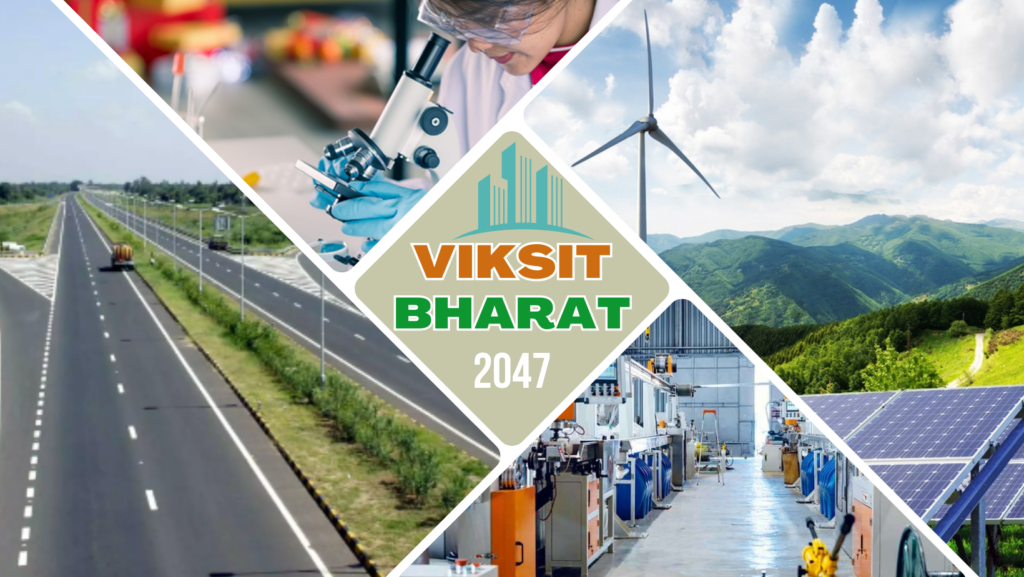February 2024

India’s goal to be a developed nation by 2047 is backed by a slew of policy reforms. What sector & business reforms are on the radar of our policymakers?
According to the World Bank, India needs to grow at about 8% over the next three decades to be classified as a high-income country. Policy support is much needed to maintain such high growth rate over the long-term. Sustained and inclusive growth is possible over the long-term if our policy makers focus on two critical inputs to the growth process: physical capital and human capital.
Government is likely to continue its expansion plans in terms of investments in large-scale infrastructure projects. The 2047 vision of becoming a developed nation is going to translate into firm action plans by key ministries across infrastructure (telecom, roadways, railways, airways), energy transition, health and skill development.
Here, we look at five key sectors that will play a key role in flavouring the secret sauce of Viksit Bharat 2047.
Connecting the DoTs
A developed and self-sufficient telecom sector is one of the key drivers of this vision. Department of Telecommunication (DoT) is already working on policy measures to capture 20% share of global manufacturing of mobile telecom technologies and increase India’s share in global supply of optical & network equipment to 25%. There is also plan to propel one Indian telecom manufacturing company to global top five optical and network technology firms.
DoT is already pursuing PLIs (production-linked incentive schemes) for telecom equipment manufacturing and promotion of R & D on 6G. There is support being rendered to startups in the telecom sector while DoT continues to remain abreast of new technologies like quantum communications.
Go Green with Energy
Energy sector will be a key driver of the 2047 goal. India is poised to become a hub for hydrogen production and export. The drive to embrace solar energy has already evolved into a nationwide movement with plans to install solar rooftops in 10 million homes for making 1crore families self-sufficient in their energy needs. India now ranks 4th in the world in renewable energy installed capacity. 40% of India’s installed energy capacity comes from non-fossil fuels. 5000 compressed biogas plants are being built. The government has already committed to direct a significant portion of the allocated budget of over INR 11lakh crore in infrastructure towards the energy sector.
Carbon Capture
As the 3rd largest emitter of CO2 in the world, India’s decision to reduce the emission intensity of its GDP by 33-35% by 2030 is an ambitious one. The government will intensify its efforts to support and facilitate Carbon Capture, Utilisation and Storage (CCUS), a technology that captures CO2 from industrial sources for other uses. Viability Gap Funding (VGF), carbon tax credit or subsidies are on the cards along with a CCUS policy framework later this year that will open up a $10billion opportunity for industries in the next five years.
In our fight against climate change, a policy along with processes for CCUS are essential to not only reduce emissions but also help oil and gas companies use the captured CO2 for enhanced oil recovery (EOR) from mature oil fields or production of chemicals.
Health & Pharma
The pharma and biopharmaceuticals industry can become a significant value creator for India with the right policy nudge. GoI has recognised this sector as a sunrise industry. Higher allocation to R&D will allow India to move up the value chain from being a volume player in generics to an innovation hub for novel therapies. The biomanufacturing scheme launched for biopharmaceuticals will help India achieve the target of $150billion bioeconomy by 2025.
The plan to extend Ayushman Bharat to ASHA workers, Anganwadi workers is a move in the right direction towards inclusive growth. It not only demonstrates our commitment to public health but paves the way for a Viksit Bharat by 2047.
Education & Skill Development
Investment in human capital is more important for inclusive growth than investment in infrastructure. With INR 37,500 crore earmarked for Samagra Shikhsha in the FY 24-25 budget, Bharat moves closer to its goal of ensuring quality education for all.
Given the pace at which technology is replacing human, it is important for the government to educate and skill people, both for keeping income disparity under control and to leverage new technologies.
An EY report estimates that GenAI could add $1.2-1.5 trillion to India’s GDP in the next 7 years, with education and upskilling as critical drivers. India can harness GenAI’s potential to empower every citizen and accelerate towards a $5 trillion economy. Skill development through emerging technologies like AI will help India unlock its demographic dividend by creating a level playing field. It’ll help India bridge the rural-urban divide and make growth more inclusive. The Indian government can work on a PPP (Private-Public Partnerships) model to leverage the opportunity AI presents for achieving its loft 2047 vision.
Does the Viksit Bharat 2047 goal seem achievable now that we’ve looked closely at some of the long-term drivers of the Indian economy and the kind of policy power propelling these drivers to surge ahead?
